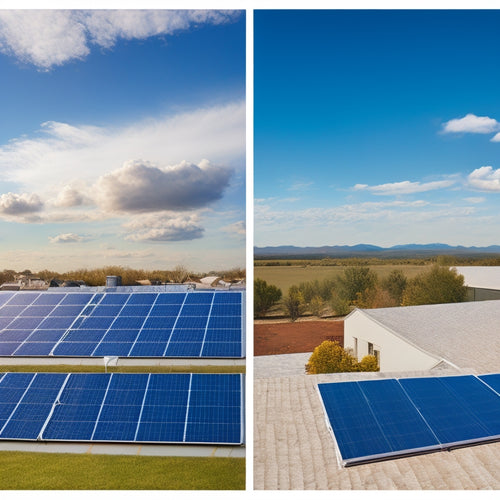
What Are the Essentials of a Home Solar System
Share
You're investing in a home solar system, and it's important to understand the fundamental components that make it work. You'll need solar panels, choosing from monocrystalline, polycrystalline, or thin-film types, considering efficiency ratings and durability. A mounting system with durable materials and professional installation is critical, as is an inverter that converts DC power to AC, with high efficiency ratings and advanced features. Add a charge controller to regulate energy flow, a battery backup for energy storage, and a monitoring system to track performance. Don't forget safety features, emergency preparedness, and system optimization to guarantee your system runs efficiently and effectively, and to get the most out of your investment, it's important to investigate these components in greater detail.
Key Takeaways
- A home solar system requires high-efficiency solar panels, a durable mounting system, and a reliable inverter to convert DC power to AC power.
- A charge controller is necessary to regulate energy flow from solar panels to batteries and prevent overcharging, ensuring safe and efficient energy storage.
- A battery backup system, such as lithium-ion batteries, allows excess energy to be stored for later use, providing energy independence and backup power during outages.
- A monitoring system provides real-time updates on energy production, consumption, and storage, enabling performance optimization and maximizing energy savings.
- Safety features, including compliance with installation guidelines, professional installation, and regular maintenance, are crucial to ensure the safe and efficient operation of a home solar system.
Solar Panels: The Energy Source
Your home solar system's energy source begins with solar panels, which convert sunlight into electrical energy through photovoltaic (PV) cells. These panels come in various types, each with its own strengths and weaknesses.
Monocrystalline silicon panels boast high efficiency ratings, often above 20%, but are more expensive. Polycrystalline silicon panels, on the other hand, offer lower efficiency ratings, around 15-18%, but are more budget-friendly. Thin-film panels, made from amorphous silicon, are the most affordable option, but their efficiency ratings are the lowest, typically around 7-14%.
When selecting solar panels, you'll want to keep in mind factors beyond just cost. Efficiency ratings, for instance, play a significant role in determining how much power your system can generate. Higher efficiency ratings mean more power per unit area, which can be particularly important if you have limited roof space.
Additionally, look for panels with durable constructions and strong warranties to guarantee your system remains reliable and efficient over its lifespan. By choosing the right solar panels for your needs, you'll be well on your way to utilizing the power of the sun and reducing your reliance on the grid.
Mounting System: Securing the Panels
The roof-mounted solar array's structural backbone is the mounting system, comprising clamps, brackets, and rails that securely fasten solar panels to your roof. This system guarantees the panels are safely and efficiently installed, withstanding various environmental conditions.
You'll need to select mounting materials that can support the weight of the panels and withstand wind, snow, and other external forces. Aluminum and stainless steel are popular choices due to their durability and resistance to corrosion.
When it comes to installation techniques, you'll need to take into account factors such as roof type, pitch, and size. A professional installer will assess your roof's condition and design a custom mounting system to maximize energy production.
They'll also verify the system is compliant with local building codes and regulations. A well-designed mounting system is vital for the long-term performance and safety of your solar array.
It's important to prioritize quality and durability when selecting mounting materials and installation techniques to guarantee your system operates at peak efficiency.
Inverter: Converting DC to AC
With your solar panels securely fastened to the roof, it's time to focus on converting the DC power they generate into usable AC power for your home. This is where the inverter comes in, playing a critical role in maximizing your system's energy output.
There are several inverter types to choose from, including string inverters, microinverters, and power optimizers. Each has its advantages and disadvantages, so it's crucial to select the right one for your specific system.
When selecting an inverter, you'll want to pay close attention to its efficiency rating. Inverter efficiency measures how effectively the device converts DC power into AC power. A higher efficiency rating means more power for your home and less energy lost as heat.
Look for an inverter with a high efficiency rating, typically above 95%. Additionally, consider an inverter with advanced features like maximum power point tracking (MPPT) and monitoring capabilities to promote peak performance and troubleshooting.
Charge Controller: Battery Management
As you shift from utilizing solar energy to storing it for later use, a charge controller becomes an essential component in your home solar system. This device regulates the flow of energy from your solar panels to your batteries, guaranteeing efficient and safe charging.
By controlling the voltage and current, a charge controller prevents overcharging or undercharging, which can greatly reduce your battery lifespan.
A high-quality charge controller also enhances charge efficiency, allowing your batteries to store as much energy as possible. This is critical, as any losses in efficiency can result in reduced power output and increased energy waste.
When selecting a charge controller, consider factors such as maximum power point tracking (MPPT), which enables the device to adjust to changing solar panel output. Additionally, look for features like temperature compensation, which helps maintain ideal charging conditions even in extreme temperatures.
Battery Backup: Storing Excess Energy
You'll need to evaluate energy storage options for your home solar system, as excess energy generated during the day can be stored for later use.
A battery backup system guarantees you have power during outages, providing a reliable source of energy when you need it most.
Energy Storage Options
Storing excess energy generated by your home solar system is crucial to maximize its benefits, especially during periods of low energy consumption.
This is where energy storage options come into play. You'll want to evaluate a battery backup system that can store excess energy generated by your solar panels during the day for use at night or during periods of low energy production.
When it comes to energy storage, you have several options to choose from. Here are some of the most popular solar battery types:
-
Lead-Acid Batteries: A cost-effective option that's been around for decades, but less energy-efficient compared to newer technologies.
-
Lithium-Ion Batteries: A popular choice for home solar systems due to their high energy efficiency and long lifespan.
-
Sodium-Ion Batteries: A newer technology that offers a potentially more cost-effective and sustainable alternative to lithium-ion batteries.
- Flow Batteries: Ideal for long-duration energy storage, these batteries are well-suited for homes with high energy demands.
When selecting an energy storage option, assess factors such as energy efficiency, lifespan, and cost to guarantee you're getting the most out of your home solar system.
Power During Outages
Your home solar system's battery backup system plays a critical role in providing power during outages. It stores excess energy generated by your solar panels during the day, allowing you to tap into it when the grid goes down. This means you'll have power independence during emergency situations, keeping your lights on, fridge running, and communication devices charged.
The battery backup system includes a deep cycle battery bank, an inverter/charger, and a monitoring system. The deep cycle batteries are designed to provide a steady flow of energy over a long period, whereas the inverter/charger converts DC power from the solar panels to AC power for your home.
The monitoring system keeps track of your energy usage, storage, and generation, ensuring you're always aware of your energy situation.
Monitoring System: Tracking Performance
Tracking the performance of your home solar system is essential to guaranteeing ideal energy production and identifying potential issues.
You need to stay on top of your system's performance to maximize your energy savings and minimize downtime. A monitoring system allows you to do just that, providing you with real-time data analytics to optimize your system's performance.
Here are the key features to look for in a monitoring system:
-
Real-time monitoring: Get instant updates on your system's performance, including energy production, consumption, and storage.
-
Performance optimization: Identify areas for improvement and receive alerts when your system is underperforming, allowing you to take corrective action.
-
Data analytics: Gain understanding into your energy usage patterns and optimize your system's performance to match your needs.
- Customizable alerts: Set up notifications for specific events, such as low energy production or system faults, to guarantee prompt attention and resolution.
Safety Features: Protection and Prevention
As you optimize your home solar system's performance, it's equally important to guarantee its safe operation. A well-designed safety feature set is critical to prevent electrical hazards, confirm fire safety, and protect your system from harsh weather conditions.
To start, your system must comply with installation guidelines and adhere to local safety regulations. This includes making certain that your system is installed by a certified professional who follows code compliance standards.
Regular system maintenance is also essential to identify potential issues before they become safety hazards.
In the event of an emergency, it's important to have emergency procedures in place, such as knowing how to shut off the system quickly and safely. Additionally, make sure you have a plan to address weather-related issues, such as securing loose components and protecting your system from lightning strikes.
Frequently Asked Questions
How Long Does It Take to Install a Home Solar System?
You'll typically spend 1-3 days on the installation process, but the overall installation timeline can take 2-6 months, depending on permits, inspections, and utility company approvals, before you're utilizing clean energy and cutting your electricity bills.
Can I Install a Solar System Myself or Diy?
As you envision utilizing the sun's energy, you wonder if you can install a solar system yourself. While possible, it's essential you follow solar installation tips and DIY safety precautions to avoid electrical shock, falls, and system malfunctions.
Are Solar Panels Resistant to Hail and Extreme Weather?
You'll be relieved to know that solar panels are built to withstand harsh weather conditions, including hail damage, thanks to their durable materials and rigorous testing for weather durability, ensuring your power generation remains uninterrupted.
Can I Use a Solar System During a Power Outage?
You can use a solar system during a power outage if you have off-grid capabilities and battery storage, allowing you to capture energy from your solar panels and store excess for later use, ensuring uninterrupted power supply.
Does a Solar System Increase My Property Value?
You'll be pleased to know that installing a solar system substantially enhances your property value, as a solar appraisal reveals increased investment benefits, making your home more attractive to potential buyers and increasing its resale value.
Related Posts
-

Why Higher Upfront Costs Are Worth It
You pay a premium for high-quality, energy-efficient products, but they're worth it. With durability testing ensuring...
-

What Makes a Road Bike-Friendly by Design?
As you plan and design roads, incorporating features like dedicated bike lanes, smooth surfaces, and traffic calming ...
-

Tracking Solar Panels Vs Fixed Panels Cost Savings
When considering solar panel options, you'll want to weigh the cost savings of tracking solar panels versus fixed pan...


